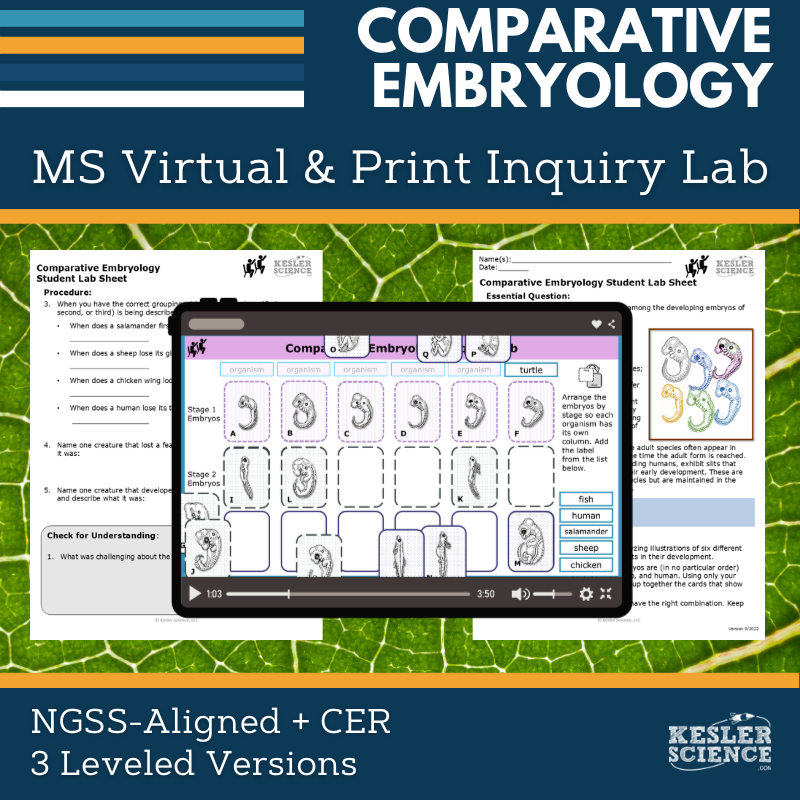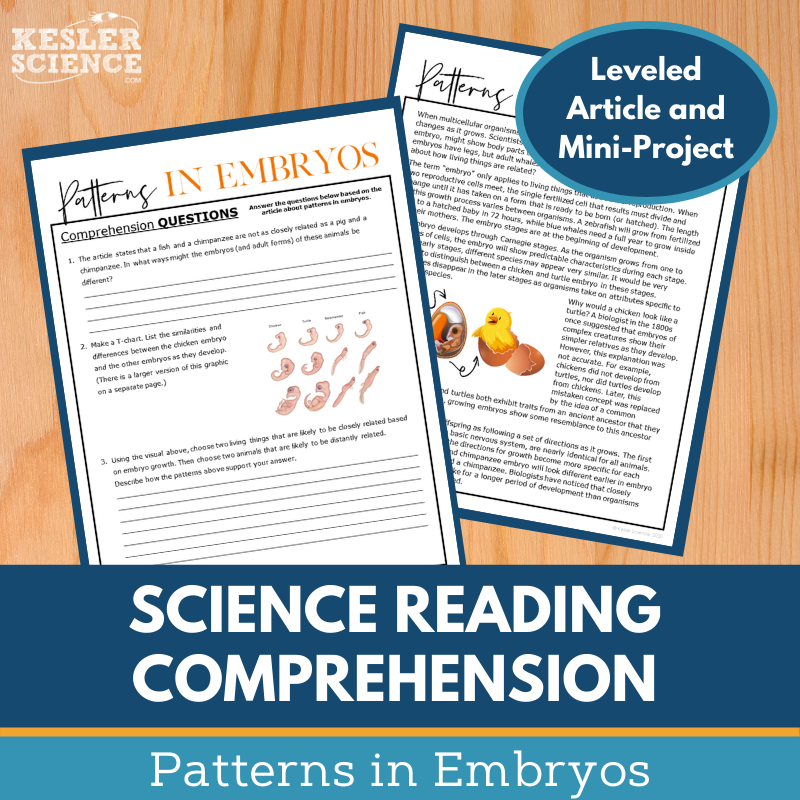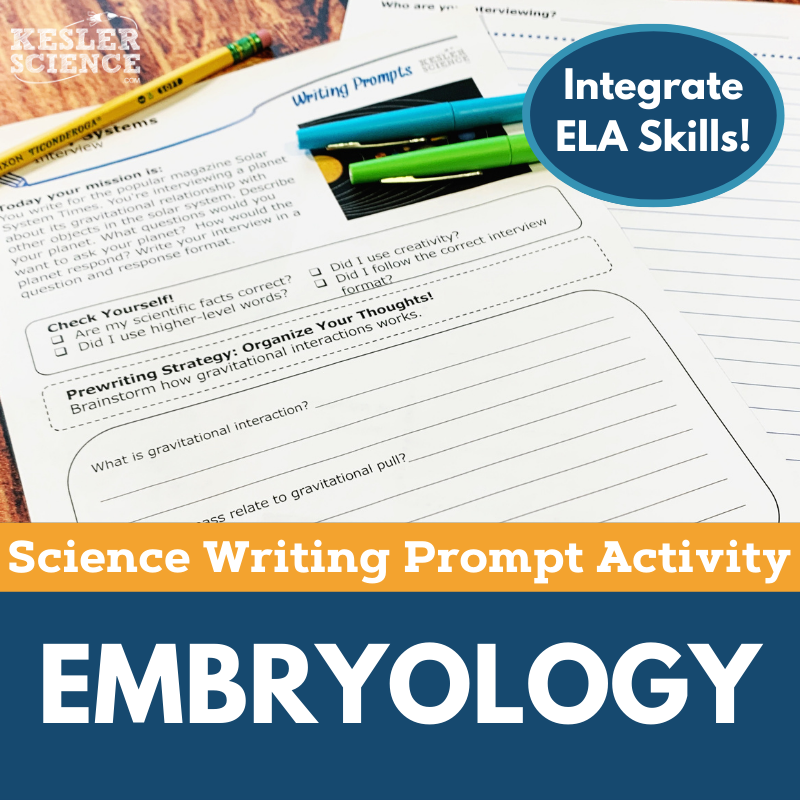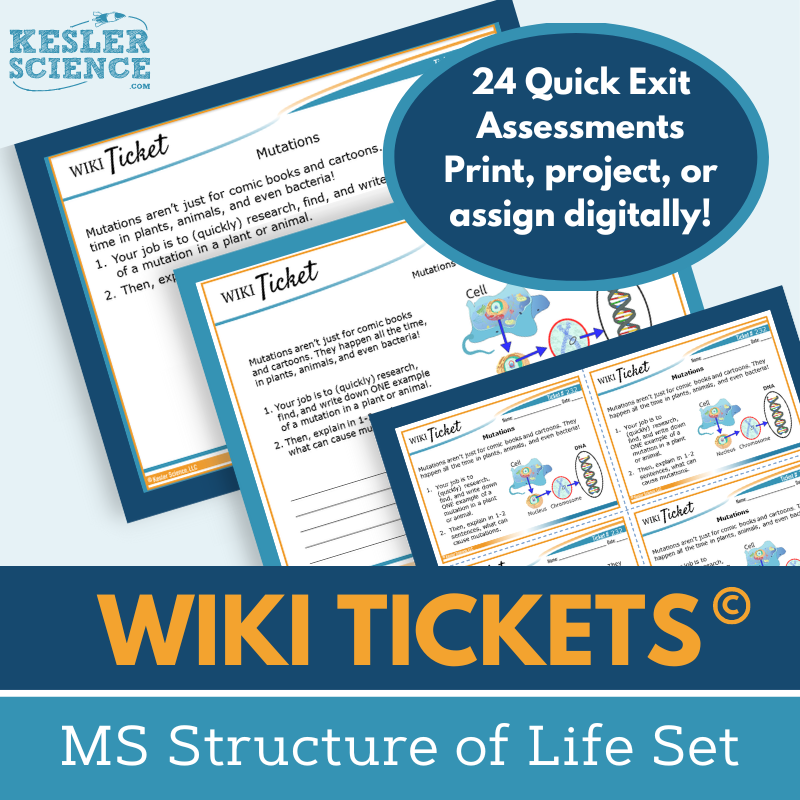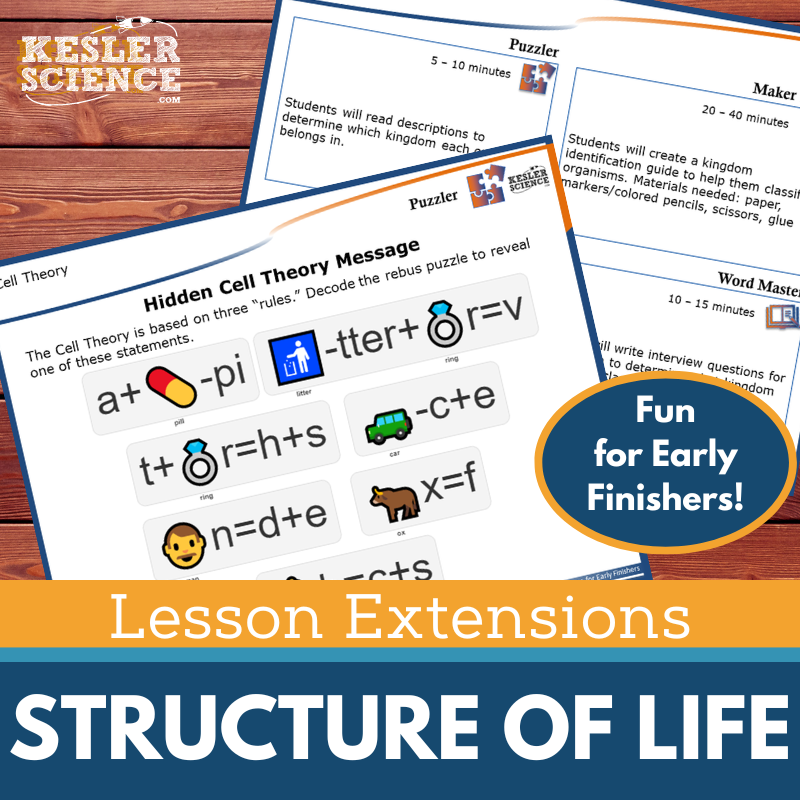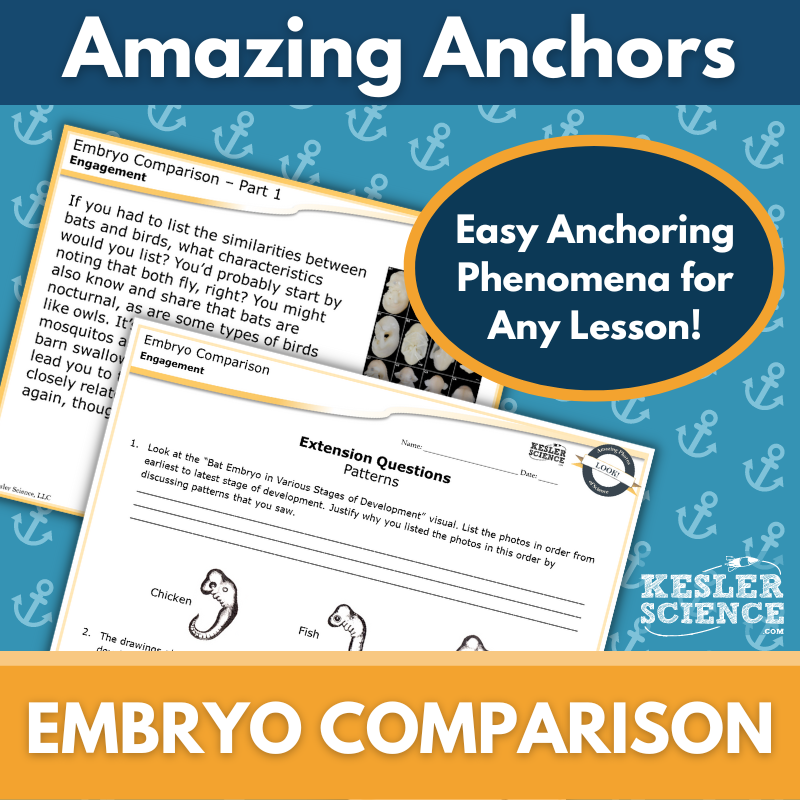Comparative Embryology Activities for Middle School Science
These lessons on comparative embryology, aligned with NGSS MS-LS4-3, engage students in analyzing patterns of embryological development across species to explore evolutionary relationships. The resources below will give students a comprehensive understanding of comparative embryology. All of the following materials are also included in the Kesler Science Membership.
The Comparative Embryology Inquiry Lab aligns with NGSS MS-LS4-3, guiding students to analyze pictorial data and compare patterns of embryological development across species. This lab is available in both interactive digital and hands-on print formats, each including comprehension questions, Claim-Evidence-Reasoning (C.E.R.) prompts, and a reflection section.
Students will examine pictorial representations of six different vertebrate embryos at three stages of development. They will attempt to label each embryo based on background knowledge and visual evidence, exploring similarities and differences in early development.
The lab includes three differentiated versions to accommodate varying learning needs. The Dependent version provides a structured approach with guided inquiry questions, the Modified version includes additional scaffolding such as sentence stems and multiple-choice options, and the Independent version allows advanced learners to take charge of their investigation with minimal guidance.
The print version involves a hands-on activity using embryo cards, while the digital version is an interactive PowerPoint compatible with Google Slides, requiring no physical materials. The resource includes editable files, teacher resource pages, answer keys, and flexible formats to support multimodal learning in middle school classrooms.
The Comparative Embryology Inquiry Lab aligns with NGSS MS-LS4-3, guiding students to analyze pictorial data and compare patterns of embryological development across species. This lab is available in both interactive digital and hands-on print formats, each including comprehension questions, Claim-Evidence-Reasoning (C.E.R.) prompts, and a reflection section.
Students will examine pictorial representations of six different vertebrate embryos at three stages of development. They will attempt to label each embryo based on background knowledge and visual evidence, exploring similarities and differences in early development.
The lab includes three differentiated versions to accommodate varying learning needs. The Dependent version provides a structured approach with guided inquiry questions, the Modified version includes additional scaffolding such as sentence stems and multiple-choice options, and the Independent version allows advanced learners to take charge of their investigation with minimal guidance.
The print version involves a hands-on activity using embryo cards, while the digital version is an interactive PowerPoint compatible with Google Slides, requiring no physical materials. The resource includes editable files, teacher resource pages, answer keys, and flexible formats to support multimodal learning in middle school classrooms.
This Science Reading Comprehension Passage helps students explore patterns of similarities in embryological development across multiple species to identify relationships not evident in fully formed anatomy. Designed for middle school, the leveled passage enhances science literacy and reading comprehension.
The resource includes a nonfiction article, five to seven comprehension questions, and a hands-on mini-project where students research and create a slideshow comparing embryo development in reptiles and birds. A Cornell notes template is provided for structured note-taking.
Suitable for in-person and virtual learning, the passage is compatible with platforms like Google Classroom, MS Teams, Schoology, and Canvas. Ideal for sub plans, ISS, extra credit, or whole-class instruction, this resource fosters critical thinking, classroom discussions, and textual analysis.
This Science Reading Comprehension Passage helps students explore patterns of similarities in embryological development across multiple species to identify relationships not evident in fully formed anatomy. Designed for middle school, the leveled passage enhances science literacy and reading comprehension.
The resource includes a nonfiction article, five to seven comprehension questions, and a hands-on mini-project where students research and create a slideshow comparing embryo development in reptiles and birds. A Cornell notes template is provided for structured note-taking.
Suitable for in-person and virtual learning, the passage is compatible with platforms like Google Classroom, MS Teams, Schoology, and Canvas. Ideal for sub plans, ISS, extra credit, or whole-class instruction, this resource fosters critical thinking, classroom discussions, and textual analysis.
The Embryology Science Writing Prompt Activity engages middle school students in a compare-and-contrast essay to reinforce their understanding of embryology. Aligned with MS-LS4-3, this activity helps students analyze pictorial data to compare patterns of similarities in embryological development across species. Designed for both in-person and virtual learning, this student-centered, low-prep activity enhances science reasoning and writing skills.
This resource includes teacher directions with answer guides and rubrics, projection and print handouts, half-sheet and full-sized templates, and a digital PowerPoint version for Google Slides. It can be used as a cross-curricular activity, pre-test assessment, student choice project, elaboration for early finishers, extra credit, make-up work, TELPAS sample, or differentiation exercise. These prompts make excellent bulletin board displays or student anthologies. Note: Students should have prior knowledge of the topic or access to research materials.
The Embryology Science Writing Prompt Activity engages middle school students in a compare-and-contrast essay to reinforce their understanding of embryology. Aligned with MS-LS4-3, this activity helps students analyze pictorial data to compare patterns of similarities in embryological development across species. Designed for both in-person and virtual learning, this student-centered, low-prep activity enhances science reasoning and writing skills.
This resource includes teacher directions with answer guides and rubrics, projection and print handouts, half-sheet and full-sized templates, and a digital PowerPoint version for Google Slides. It can be used as a cross-curricular activity, pre-test assessment, student choice project, elaboration for early finishers, extra credit, make-up work, TELPAS sample, or differentiation exercise. These prompts make excellent bulletin board displays or student anthologies. Note: Students should have prior knowledge of the topic or access to research materials.
The WIKI Tickets© Structure of Life Set offers 24 formative assessments designed for 6th-8th grade science, providing flexible and engaging ways to check student understanding. Each topic is available in five formats: a full-screen projection version, three printable handout sizes, and an interactive digital version compatible with PowerPoint and Google Slides.
Aligned with NGSS and TEKS standards, these assessments cover essential life science topics such as cell function, comparing skeletal structures, heredity, reproduction, levels of cellular organization, and genetic mutations. A bonus table of contents file is included to show standard alignment. These WIKI Tickets© can be used for in-person or virtual learning, making them versatile for any classroom setting. Students can respond on paper, digitally, or in a remote 1:1 environment. Use them as exit tickets, bellringers, or quick checks to assess student progress effectively.
The WIKI Tickets© Structure of Life Set offers 24 formative assessments designed for 6th-8th grade science, providing flexible and engaging ways to check student understanding. Each topic is available in five formats: a full-screen projection version, three printable handout sizes, and an interactive digital version compatible with PowerPoint and Google Slides.
Aligned with NGSS and TEKS standards, these assessments cover essential life science topics such as cell function, comparing skeletal structures, heredity, reproduction, levels of cellular organization, and genetic mutations. A bonus table of contents file is included to show standard alignment. These WIKI Tickets© can be used for in-person or virtual learning, making them versatile for any classroom setting. Students can respond on paper, digitally, or in a remote 1:1 environment. Use them as exit tickets, bellringers, or quick checks to assess student progress effectively.
Lesson Extensions provide engaging, student-choice activities designed to challenge early finishers and deepen their understanding of life science concepts. These activities help reinforce critical thinking, creativity, and problem-solving while keeping students engaged with rigorous yet enjoyable learning opportunities. They are ideal for lesson wrap-ups, independent challenges, and filling downtime during testing.
Each extension includes four interactive components: Puzzler for problem-solving, Maker Space for hands-on STEAM activities, Tech Connection for digital demonstrations, and Word Master for creative writing. With teacher directions, answer keys, and both print and projection versions, these extensions support flexible learning and enrichment.
Covering topics such as artificial selection, body systems, cell functions, genetic variations, heredity, and natural selection, Lesson Extensions align with NGSS and TEKS science standards, ensuring meaningful connections to curriculum goals.
Lesson Extensions provide engaging, student-choice activities designed to challenge early finishers and deepen their understanding of life science concepts. These activities help reinforce critical thinking, creativity, and problem-solving while keeping students engaged with rigorous yet enjoyable learning opportunities. They are ideal for lesson wrap-ups, independent challenges, and filling downtime during testing.
Each extension includes four interactive components: Puzzler for problem-solving, Maker Space for hands-on STEAM activities, Tech Connection for digital demonstrations, and Word Master for creative writing. With teacher directions, answer keys, and both print and projection versions, these extensions support flexible learning and enrichment.
Covering topics such as artificial selection, body systems, cell functions, genetic variations, heredity, and natural selection, Lesson Extensions align with NGSS and TEKS science standards, ensuring meaningful connections to curriculum goals.
This Amazing Anchors Phenomenon Lesson introduces and reinforces embryological similarities through real-world connections. It begins with an introductory reading comparing bats and birds, followed by comprehension and extension questions to deepen student understanding. An explanatory reading then breaks down the stages of embryonic development in an accessible way, with additional questions to reinforce learning.
Aligned with NGSS standard LS4-3, this no-prep resource includes teacher directions, answer keys, projection slides, and print and digital formats for Google Classroom and other LMS platforms. A differentiated version provides sentence starters for student support. Designed to bookend a lesson, these engaging readings serve as supplements to reinforce learning in any in-person or virtual classroom.
This Amazing Anchors Phenomenon Lesson introduces and reinforces embryological similarities through real-world connections. It begins with an introductory reading comparing bats and birds, followed by comprehension and extension questions to deepen student understanding. An explanatory reading then breaks down the stages of embryonic development in an accessible way, with additional questions to reinforce learning.
Aligned with NGSS standard LS4-3, this no-prep resource includes teacher directions, answer keys, projection slides, and print and digital formats for Google Classroom and other LMS platforms. A differentiated version provides sentence starters for student support. Designed to bookend a lesson, these engaging readings serve as supplements to reinforce learning in any in-person or virtual classroom.
Year-Round Resources
These year-round activities will increase your students' understanding of many middle school science topics. All of these activities are also included in the Kesler Science Membership.
Visual Data & Graphing
You're not alone if your students struggle with understanding graphs, charts, and tables. It's a skill that takes an enormous amount of practice. This resource will help students build a strong foundation in analyzing data and creating their own data visualizations.
Bell Ringers and Warm-Ups
These middle school science bell ringers are an excellent way to engage your students as soon as they walk into your classroom. This comprehensive FULL YEAR resource includes everything you need to start off each science class with an interesting warm-up activity.
Review Board Games
Each game board has been carefully designed to keep students engaged. There are 10 different action spaces on each board and dozens of question cards. All of the actions are related to science concepts and keep the students motivated throughout the game.
Each game is ready to play. Simply print out the board and the cards and let the students enjoy reviewing nine different units.
Essential Questions and Standards
Below are the essential questions and standards associated with the lessons and activities included in the comparative embryology unit. This topic is only one of more than 100 middle school science topics included in the Kesler Science Membership.
-
What are the similarities and differences among the developing embryos of various vertebrates?
-
NGSS - MS-LS4-3 Comparative Embryology
Kesler Science Membership
Imagine never having to search for another middle school science lesson again. The membership gives you access to ALL of the Kesler Science products in one place (Yes, including everything above).
Say goodbye to long hours of lesson prep.

